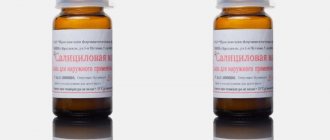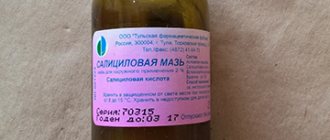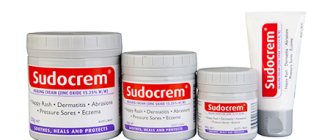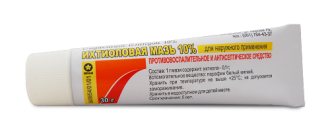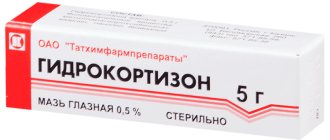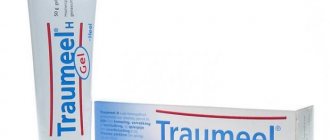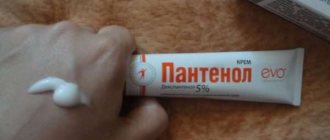Release form and mechanism of action
In metal tubes of 3, 7 and 10 grams.
Active ingredient – tetracycline – 10 mg per 1 gram of the drug.
Tetracycline destroys the connections between ribosomes and transfer RNA of bacteria, which disrupts protein synthesis in them and makes it impossible for them to reproduce.
Effectively suppresses microorganisms. Among those suppressed by it: clostridia, streptococci, staphylococci, spirochetes, mycoplasma, E. coli, leptospira, gonococcus, pneumococcus, rickettsia, chlamydia.
Among those resistant to it are: a group of fungi, Protea, Pseudomonas aeruginosa.
The frequency of use of Tetracycline ointment is decreasing due to the development of resistance of microorganisms to it and the emergence of more powerful antibiotics.
Compound
The active ingredient of the ointment is tetracycline. This is a tetracycline antibiotic, which is included in the list of vital medicines.
Tetracycline has an antibacterial and bactericidal effect against gram-positive and gram-negative microorganisms, which, when they get on the mucous membranes of the eyes, begin to actively multiply and secrete toxins - waste products of bacteria that cause local or systemic intoxication.
Tetracycline ointment is effective for conjunctivitis caused by staphylococci (including Staphylococcus aureus, which is difficult to treat and is the main causative agent of hospital infections).
The ointment can also be included in the complex therapy of ophthalmoblennorrhea, a purulent lesion of the ocular conjunctiva that develops against the background of infection with gonococci. The disease is often a complication of sexually transmitted infections (gonorrhea) and may require the use of combined treatment regimens, when other antibiotics are prescribed simultaneously with tetracycline.
- The following are used as auxiliary components in production:
- lanolin - a waxy base evaporated from sheep's wool;
- Vaseline - necessary to give the desired consistency.
The amount of tetracycline in 1 g of ointment is 10,000 mcg, that is, the concentration of the active substance in the drug is 1%.
Mode of application
The ointment is used exclusively topically.
According to the instructions for using tetracycline eye ointment, squeeze out a strip of ointment about 0.5 cm long, then carefully place it behind the lower eyelid.
In this case, use a special spatula or fingertip. The procedure is repeated after 2-4 hours in the same sequence.
When applying the ointment, do not touch the mucous membrane of the eyes with the tip of the tube , otherwise you can injure it. After completing the manipulation, it is recommended to lie down for a few minutes with your eyelids closed. Excess product should be removed with a cotton pad, paper or gauze napkin.
The course of therapy lasts 1-2 months and depends on the severity of the pathology. During treatment, blurred or blurred vision may occur. There is no need to be afraid of this.
Along with ointment, systemically acting medications can also be used as prescribed by a doctor.
Treatment of burns with ointment
Exposure to high temperatures (over 60°C), chemical compounds, and electric current cause burns. Not only the skin is damaged, but also the mucous membranes of the eyes, nose, and mouth. At the initial stage of treatment, medications are used to relieve pain and cool injuries. Many of them contain dexpanthenol, which promotes rapid tissue healing.
Traumatologists prescribe tetracycline ointment for burns when weeping wounds form on the skin. Pathogenic bacteria penetrate into them from the surrounding space and begin to actively multiply. Despite the use of antiseptics, tissue restoration does not occur. On the contrary, the edges of the wound begin to redden and become inflamed, and suppuration appears. Only the use of ointments with antibiotics can quickly cope with infection and speed up regeneration.
Eye burns
Most often, ophthalmologists diagnose retinal burns that occur under the influence of temperature.
But the most dangerous injuries are caused by the ingress of chemicals - acids, alkalis, heavy metals.
In such cases, only timely medical care can help a person preserve his vision. After an eye burn, the following symptoms quickly appear:
- severe lacrimation;
- redness of the mucous membrane;
- increased sensitivity to light.
Tetracycline 1% ointment is used immediately at the initial stage of treatment of a chemical burn. When used, it is possible to prevent the development of edema and inflammation caused by pathogenic microbes. Ophthalmologists recommend placing an antibacterial agent behind the eyelid even at the stage of providing first aid to the victim.
Chemical burn
Chemical burns of the skin or mucous membranes can occur both at home and at work. The most dangerous injuries are caused by alkalis—lime, ammonia solution, and cleaning agents. When concentrated chemicals come into contact with the skin, a wound surface immediately forms. Even timely treatment with an antiseptic is not able to prevent infection. Traumatologists prescribe ointments to patients for 3-4 times application to the affected surface:
- Levomekol;
- Tetracycline;
- Levomycetinic.
The active ingredients of antibacterial ointments quickly penetrate into inflammatory foci and destroy pathogens.
Using these medications also helps prevent the formation of scars and scars.
Radiation influence
Eye damage is often caused by ultraviolet radiation, for example, during gas welding work. 1st or 2nd degree skin burns occur due to prolonged exposure to the sun.
Such lesions are very painful and, if left untreated, can become inflamed and infected. It is necessary to apply antibacterial ointments when redness and swelling spread to healthy areas of the skin.
Quite rarely, burns occur as a result of ionizing radiation. It is actively used in instrumental diagnosis of the disease and chemotherapy. Such skin damage can only be caused by exceeding a certain level of radiation dose.
Principles of first aid for burns
After removing the source of the burn, the damaged areas must be cooled under running water. This is especially true when injured by chemicals, as it allows you to quickly wash off the acid or alkali. The skin should be cooled under running water for 15-20 minutes, after which it is treated with antiseptics:
- Miramistin;
- Chlorhexidine;
- Furacilin.
To prevent infection, apply a sterile napkin to the damaged area and secure it with a bandage. When providing first aid to a victim, do not use ointments, creams or balms. After removing the bandage, treat with drugs containing dexpanthenol.
Often a severe burn provokes hyperthermia. At a temperature above 38°C, Ibuprofen or Nimesulide should be given to the victim right at the point of first aid.
Treatment of burns at the rehabilitation stage
During the recovery period, it is necessary to use Tetracycline ointment to prevent infection with staphylococci or streptococci. If microorganisms have already penetrated the wound, then the antibacterial drug will prevent their growth and reproduction. In addition to Tetracycline ointment, the following is used:
- Levomekol;
- Levosin.
To accelerate epithelization, the doctor prescribes tissue regeneration stimulants. They contain substances that accelerate cell division in damaged areas of the skin and mucous membranes. Such drugs include Bepanten, Solcoseryl, Baneocin (instructions).
Prognosis and consequences of eye burns
Timely treatment of a superficial burn helps prevent unwanted consequences. Damaged tissues are restored within a few weeks, and lacrimation and redness disappear after 2-3 days. The following eye drops can be used to speed up regeneration:
- Etaden;
- Etadex.
Their principle of action is based on stimulation of metabolism in the cornea and conjunctiva. Using drops three times a day significantly speeds up recovery. The prognosis for complete recovery is unfavorable with significant damage to the retina. The consequences of a burn are partial or complete loss of vision.
Side effects
- Allergy;
- Dyspeptic disorders: vomiting, diarrhea, lack of appetite;
- Fungal infections of the skin , most often by candida fungi, with prolonged or unsystematic use;
- Inflammation of the mucous membranes of the oral cavity;
- Exacerbation of inflammation of the stomach and rectum;
- Increased sensitivity of the skin to solar radiation and the formation of burns on it (with direct and prolonged exposure);
- Giving a rich yellow color to tooth enamel in children (during tooth growth).
If side effects develop, the drug is discontinued and replaced with an antibiotic that does not contain tetracycline.
Application for children
Tetracycline eye ointment for children is allowed to be used if indicated at the age of at least 8 years . This is only possible on the recommendation of a specialist. As an exception, ophthalmologists prescribe 1% tetracycline eye ointment for children under one year of age. But parents are not allowed to do this without permission, without consulting an ophthalmologist.
The 3% drug is not prescribed to newborns, since when the drug enters the blood through the skin, transformations occur in the baby’s body, leading to darkening of the enamel of the teeth, which should erupt in the near future.
When a pediatrician prescribes tetracycline ointment for the treatment of infectious eye diseases in children, it is necessary to strictly follow the rules of use and dosage.
Analogs
There are no absolute structural analogues of the drug in the same dosage form, so if the drug is poorly tolerated, the doctor can select a drug with similar pharmacological properties from the group of topical antibiotics.
- Tobrex (172 rubles). Eye drops with a concentration of active substance of 0.3%. Not compatible with tetracycline drugs. Long-term use may cause the development of fungal superinfection.
- Levomycetin (from 7 to 30 rubles). Eye drops with high antibacterial activity against most strains of gram-negative and gram-positive bacteria. They have many contraindications and cannot be used during pregnancy or for treating children under 2 years of age.
- Colbiocin (344 rubles). Available in the form of eye ointment and powder for the preparation of eye drops. A combined antibacterial drug, can be used in children from 8 years of age.
The listed medications have certain contraindications and side effects, so you should consult your doctor before using them.
Special instructions and interactions with other drugs
Patients who see a blurred visual image after using Tetracycline ointment are not recommended to take control of a car, complex equipment, etc. during treatment.
Do not use ointment during teething in children to prevent the enamel from turning yellow.
Prescribing Tetracycline ointment requires caution if the patient is susceptible to food allergies or hay fever, even if it is not used during their exacerbation.
Tetracycline eye ointment significantly enhances the effectiveness of glucocorticosteroids; this should be taken into account when calculating their dose.
If a few days after treatment the patient’s condition does not improve, it is necessary to visit an ophthalmologist.
Pregnant and lactating women should use the medication with caution, since the drug has not been tested on this group of patients.
In this case, the patient can use the ointment after a doctor’s prescription. The drug is prescribed only if the positive effect on the mother outweighs the potential risk to the baby.

